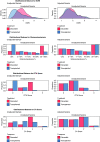Assessment of the Utility of Kidney Histology as a Basis for Discarding Organs in the United States: A Comparison of International Transplant Practices and Outcomes
- PMID: 33323474
- PMCID: PMC8054891
- DOI: 10.1681/ASN.2020040464
Assessment of the Utility of Kidney Histology as a Basis for Discarding Organs in the United States: A Comparison of International Transplant Practices and Outcomes
Abstract
Background: Many kidneys donated for transplant in the United States are discarded because of abnormal histology. Whether histology adds incremental value beyond usual donor attributes in assessing allograft quality is unknown.
Methods: This population-based study included patients who received a deceased donor kidney that had been biopsied before implantation according to a prespecified protocol in France and Belgium, where preimplantation biopsy findings are generally not used for decision making in the allocation process. We also studied kidneys that had been acquired from deceased United States donors for transplantation that were biopsied during allocation and discarded because of low organ quality. Using donor and recipient characteristics, we fit multivariable Cox models for death-censored graft failure and examined whether predictive accuracy (C index) improved after adding donor histology. We matched the discarded United States kidneys to similar kidneys transplanted in Europe and calculated predicted allograft survival.
Results: In the development cohort of 1629 kidney recipients at two French centers, adding donor histology to the model did not significantly improve prediction of long-term allograft failure. Analyses using an external validation cohort from two Belgian centers confirmed the lack of improved accuracy from adding histology. About 45% of 1103 United States kidneys discarded because of histologic findings could be accurately matched to very similar kidneys that had been transplanted in France; these discarded kidneys would be expected to have allograft survival of 93.1% at 1 year, 80.7% at 5 years, and 68.9% at 10 years.
Conclusions: In this multicenter study, donor kidney histology assessment during allocation did not provide substantial incremental value in ascertaining organ quality. Many kidneys discarded on the basis of biopsy findings would likely benefit United States patients who are wait listed.
Keywords: epidemiology and outcomes; kidney biopsy; kidney transplantation; pathology; transplant outcomes.
Copyright © 2021 by the American Society of Nephrology.
Figures



Comment in
-
Authors' Reply.J Am Soc Nephrol. 2021 May 3;32(5):1264-1265. doi: 10.1681/ASN.2021020207. Epub 2021 Apr 28. J Am Soc Nephrol. 2021. PMID: 33910999 Free PMC article. No abstract available.
-
Procurement Biopsy Data Quality Limits Comparability of United States and French Deceased Donor Kidney Biopsies.J Am Soc Nephrol. 2021 May 3;32(5):1263-1264. doi: 10.1681/ASN.2020121788. Epub 2021 Apr 28. J Am Soc Nephrol. 2021. PMID: 33911001 Free PMC article. No abstract available.
References
-
- Organ Procurement and Transplantation Network: National Data: Overall by Organ. Available at: https://optn.transplant.hrsa.gov/data/view-data-reports/national-data/#. Accessed December 6, 2019
-
- Cooper M, Formica R, Friedewald J, Hirose R, O’Connor K, Mohan S, et al. .: Report of National Kidney Foundation Consensus Conference to decrease kidney discards. Clin Transplant 33: e13419, 2019 - PubMed
-
- Trump DJ: Executive order on Advancing American Kidney Health, 2019. Available at: https://www.whitehouse.gov/presidential-actions/executive-order-advancin.... Accessed October 29, 2020
Publication types
MeSH terms
LinkOut - more resources
Full Text Sources
Medical

